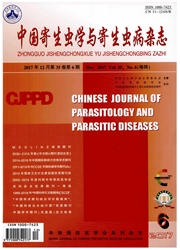

 中文摘要:
中文摘要:
目的利用蛋白质组学的方法鉴定吡喹酮处理前后日本血吸虫成虫蛋白质组,比较处理前后差异表达的蛋白质,探讨吡喹酮抗血吸虫机制。方法日本血吸虫合抱成虫分别暴露于吡喹酮(处理组,30μg/m1)和二甲基亚砜(对照组)中,18h后收集虫体,提取总蛋白。采用二维-纳喷雾-液相色谱联合串联质谱(2D—nano-LC—MS/MS)鉴定吡喹酮处理组与对照组的蛋白质。数据库查询确定蛋白质的功能,统计分析其中差异表达的蛋白质。结果吡喹酮处理后明显上调的血吸虫成虫蛋白为12个,明显下调4个。上调蛋白中有10个功能明确,分别归属于细胞骨架蛋白家族的肌动蛋白、肌球蛋白、副肌球蛋白、微管蛋白、原肌球蛋白和膜联蛋白,应激蛋白家族的热休克蛋白70、热休克蛋白60和硫氧还原蛋白过氧化物酶和信号转导蛋白14—3—3。下调蛋白为参与转录调控的蛋白.即多聚合蛋白和髓磷脂基因表达因子。结论吡喹酮处理后日本血吸虫成虫蛋白质组具有差异,提示吡喹酮处理后促进或抑制了特定基因的表达。
 英文摘要:
英文摘要:
Objective To analyze differentially expressed proteins of pairing adult Schistosoma japonicum treated with praziquantel so as to further explore the action mechanism of praziquantel (PZQ). Methods Pairing adult worms were collected and exposed to PZQ (30 μg/ml) for 18 h with dimethyl sulfoxide (DMSO) treatment as control. The total protein was extracted. Proteins from two groups were identified by two-dimensional-nano-liquid chromatography coupled by tandem mass spectrometry (2D-nano-LC-MS/MS). Query in database was made to confirm functions of the proteins. Differentially expressed proteins were analyzed statistically. Results There were 12 proteins up-regulated and 4 proteins down-regulated in the treated group compared with the untreated. Ten of the 12 up-regulated proteins were with known function, respectively ascribed to myosin, actin, paramyosin, tropomyosin, tubulin, annexin, stress response HSP70, HSP60 and thioredoxin perioxidase, signal transaction molecule 14-3-3. The down-regulated proteins were molecules with translational/transcriptional regulation, such as polyprotein and myelin gene expression factor. Conclusion There is a significant difference in proteomics between the PZQ-treated and untreated worms, suggesting that PZQ can increase or inhabit the expression of specific genes in adult Schistosoma japonicum.
 同期刊论文项目
同期刊论文项目
 同项目期刊论文
同项目期刊论文
 期刊信息
期刊信息
